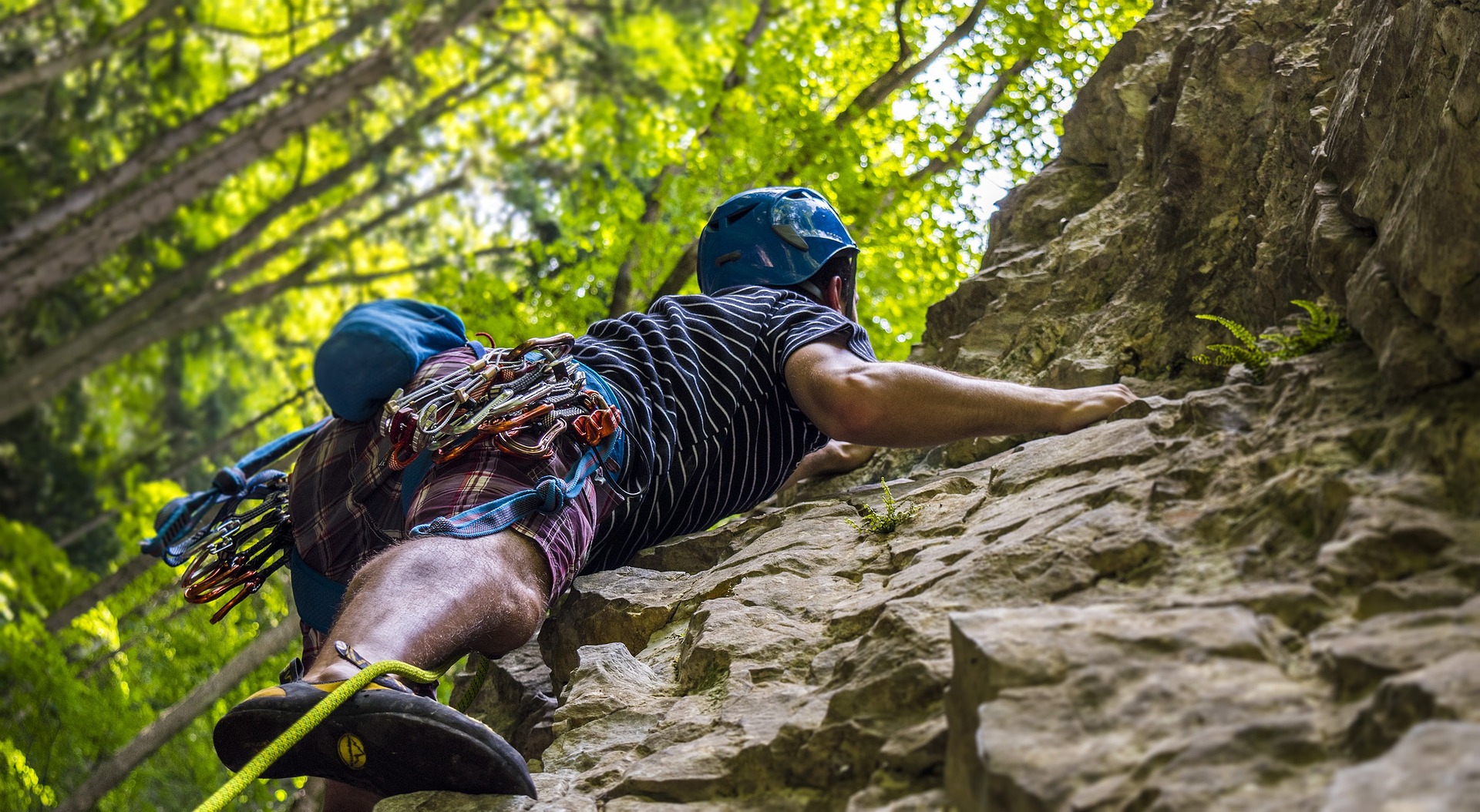Bouldering: The Vertical Chess of Rock Climbing
Imagine scaling a wall without ropes, relying solely on your strength, flexibility, and problem-solving skills. This is the essence of bouldering, a discipline that's rapidly reshaping the landscape of rock climbing. As climbers push the boundaries of what's possible on vertical terrain, bouldering has emerged as a thrilling blend of physical prowess and mental acuity.

Unlike traditional rock climbing, which involves scaling tall cliffs with ropes and harnesses, bouldering focuses on shorter, more intense routes called “problems.” These problems typically range from 10 to 20 feet in height and require a series of complex moves to complete. The absence of ropes means that falls are cushioned by crash pads placed beneath the climber, adding an element of calculated risk to the sport.
The simplicity of bouldering equipment – just climbing shoes and chalk – has contributed to its accessibility and popularity. This minimalist approach allows climbers to focus entirely on the nuances of movement and problem-solving, earning bouldering the moniker “vertical chess.”
The Physics and Biomechanics of Bouldering
At its core, bouldering is a study in applied physics and biomechanics. Climbers must constantly navigate the interplay between gravity, friction, and their own body mechanics to ascend seemingly impossible routes. Understanding these principles is crucial for success in the sport.
One key concept is that of center of gravity. Skilled boulderers learn to position their bodies in ways that keep their center of gravity close to the wall, reducing the force required to maintain contact with the rock. This often involves counterintuitive positions, such as keeping the hips close to the wall even when feet are on distant holds.
Friction plays a vital role in bouldering, particularly in slab climbing where the angle of the rock is less than vertical. Climbers must develop an intuitive sense of how much pressure to apply to maximize friction without causing their muscles to fatigue prematurely. This delicate balance is often referred to as “quiet feet” – the ability to place feet precisely and silently on small holds.
The principle of momentum is also crucial in bouldering. Dynamic moves, where climbers launch themselves to distant holds, require a precise application of force and timing. These moves often involve generating momentum from the legs and core, then redirecting it through the arms to reach the target hold.
Grading Systems and Problem Solving
Bouldering problems are categorized using various grading systems, with the V-scale being the most widely used in North America. This scale, developed by John Sherman in the 1980s, ranges from V0 (easiest) to V17 (hardest), with each grade representing a significant increase in difficulty.
The process of solving a bouldering problem is akin to decoding a puzzle. Climbers must analyze the sequence of moves required to reach the top, considering factors such as hand and foot placements, body positioning, and the most efficient use of energy. This mental aspect of bouldering is as challenging as the physical demands, requiring climbers to visualize sequences and adapt their strategies on the fly.
Advanced boulderers often spend considerable time “reading” a problem before attempting it, mentally mapping out each move and considering alternative approaches. This process, known as “beta,” involves not just planning the sequence of moves but also determining the optimal body positioning and grip techniques for each hold.
The problem-solving aspect of bouldering extends beyond individual climbs. Climbers must also manage their energy levels across multiple attempts, deciding when to rest and how to pace themselves to maximize their chances of success. This strategic element adds depth to the sport, rewarding not just physical prowess but also patience and tactical thinking.
Training Methodologies for Bouldering
The unique demands of bouldering have led to the development of specialized training methodologies. These programs focus on developing the explosive strength, finger power, and core stability required for tackling difficult problems.
Hangboard training has become a cornerstone of bouldering-specific workouts. These devices, featuring various grip positions, allow climbers to systematically improve finger strength and endurance. Advanced hangboard protocols, such as the Max Hangs method developed by Eva López-Rivera, have shown significant improvements in grip strength and climbing performance.
Campus board training, involving dynamic movements on a series of wooden rungs, is another popular tool for developing power and contact strength. This type of training, pioneered by Wolfgang Güllich in the 1980s, simulates the explosive movements often required in bouldering.
Core strength is crucial in bouldering, as it allows climbers to maintain body tension and execute complex movements. Training regimens often include a variety of planks, leg lifts, and rotational exercises to develop a strong and stable core.
Flexibility and mobility are also key components of bouldering performance. Many climbers incorporate yoga or dedicated stretching routines into their training to improve their range of motion and ability to execute technical moves.
Mental training is increasingly recognized as a critical aspect of bouldering performance. Techniques such as visualization, mindfulness, and cognitive behavioral strategies are employed to help climbers manage fear, maintain focus, and approach problems with a positive mindset.
The Rise of Indoor Bouldering and Competitions
The growth of indoor climbing gyms has played a significant role in the popularization of bouldering. These facilities offer a controlled environment where climbers can practice year-round, regardless of weather conditions. Indoor walls also allow for the creation of diverse and challenging problems that might not naturally occur outdoors.
Competitive bouldering has evolved into a highly structured sport, with events ranging from local gym competitions to international championships. The International Federation of Sport Climbing (IFSC) oversees World Cup events and has successfully lobbied for the inclusion of sport climbing, including bouldering, in the Olympic Games.
Competitive bouldering format typically involves a series of problems that must be completed within a set time limit. Climbers are scored based on the number of problems completed and the number of attempts required. This format tests not only physical abilities but also mental stamina and problem-solving skills under pressure.
The design of competition bouldering problems has become an art form in itself. Route setters create increasingly complex and innovative problems that challenge climbers in new ways, often incorporating dynamic movements, precarious balancing acts, and counterintuitive sequences.
Environmental and Ethical Considerations
As bouldering’s popularity has grown, so too has awareness of its environmental impact. The concentration of climbers in popular bouldering areas can lead to erosion, vegetation damage, and disturbance of wildlife habitats. In response, climbing organizations have developed guidelines for minimizing impact, such as using established trails, avoiding climbing on wet rock, and respecting seasonal closures for wildlife protection.
The ethics of adding new boulder problems or altering existing ones is a topic of ongoing debate within the climbing community. Some argue for a purist approach, leaving the rock as natural as possible, while others advocate for limited alterations to create safer or more enjoyable climbs. This debate reflects the broader tension between access, conservation, and the desire to push the boundaries of the sport.
The use of chalk, essential for maintaining grip on the rock, has also come under scrutiny due to its visual impact and potential effects on rock chemistry. Some areas have implemented restrictions on chalk use or encouraged the use of colored chalk that blends with the rock.
Bouldering’s Impact on Physical and Mental Health
Beyond its appeal as a sport, bouldering has gained recognition for its potential benefits to physical and mental health. The full-body workout provided by bouldering engages multiple muscle groups, improves flexibility, and enhances proprioception – the body’s ability to sense its position in space.
Research has also highlighted bouldering’s positive effects on mental health. A study published in the journal BMC Psychiatry found that bouldering can be an effective adjunct treatment for depression, with participants showing significant improvements in depressive symptoms after an eight-week bouldering intervention.
The problem-solving aspect of bouldering has been linked to improved cognitive function and creativity. The sport requires constant adaptation and learning, which may contribute to neuroplasticity – the brain’s ability to form new neural connections throughout life.
The social nature of bouldering, with climbers often working together to solve problems and provide encouragement, can foster a sense of community and support. This social aspect has been cited as a factor in the sport’s positive impact on mental well-being.
Technological Innovations in Bouldering
While bouldering remains a relatively low-tech sport, technological innovations have begun to influence training methods and performance analysis. Wearable devices that track metrics such as grip strength, movement patterns, and energy expenditure are providing climbers with data-driven insights into their performance.
3D scanning and printing technologies are being used to create highly detailed replicas of outdoor boulders for indoor training. These artificial boulders allow climbers to practice specific problems and movements in a controlled environment, potentially accelerating skill development.
Virtual reality (VR) and augmented reality (AR) applications are emerging as tools for route visualization and training. These technologies allow climbers to virtually experience and analyze problems before attempting them in real life, potentially enhancing preparation and reducing injury risk.
Advances in materials science are leading to the development of new climbing shoes with improved grip, durability, and comfort. Some manufacturers are exploring the use of biomimetic materials inspired by the adhesive properties of gecko feet to create shoes with enhanced friction on various rock types.
The Future of Bouldering
As bouldering continues to evolve, several trends are shaping its future trajectory. The sport’s inclusion in the Olympics is likely to drive further growth and mainstream recognition, potentially leading to increased funding and development of training facilities.
The push for ever-harder boulder problems shows no signs of slowing, with elite climbers continually redefining what is possible on rock. This progression may lead to further specialization within the sport, with climbers focusing on specific styles or types of problems.
Environmental concerns are likely to play an increasingly important role in shaping bouldering practices and policies. The development of sustainable climbing techniques and products, such as biodegradable chalk and eco-friendly crash pads, may become more prevalent.
The intersection of bouldering with other disciplines, such as parkour and gymnastics, may lead to new hybrid forms of movement and competition. This cross-pollination of ideas could further expand the boundaries of what is considered possible in vertical terrain.
As research continues to uncover the physical and mental health benefits of bouldering, the sport may increasingly be integrated into therapeutic and wellness programs. This could lead to broader recognition of climbing as a tool for promoting overall health and well-being.
Conclusion
Bouldering stands at the intersection of physical challenge, mental acuity, and artistic expression. Its evolution from a training method to a standalone discipline reflects the human drive to explore the limits of physical and mental capabilities. As the sport continues to grow and evolve, it offers not just a path to athletic achievement but also a means of personal growth, community building, and connection with the natural world.
The vertical chess of bouldering challenges participants to constantly adapt, innovate, and push beyond perceived limitations. Whether scaling indoor walls or tackling remote mountain boulders, climbers engage in a pursuit that demands total focus, creativity, and a willingness to embrace failure as a step toward success.
As we look to the future, bouldering’s blend of physicality, problem-solving, and environmental engagement positions it as more than just a sport – it’s a microcosm of the human experience, played out on vertical terrain. The continued evolution of bouldering promises to offer new challenges, insights, and opportunities for personal and collective growth, ensuring its place as a dynamic and inspiring pursuit for generations to come.





